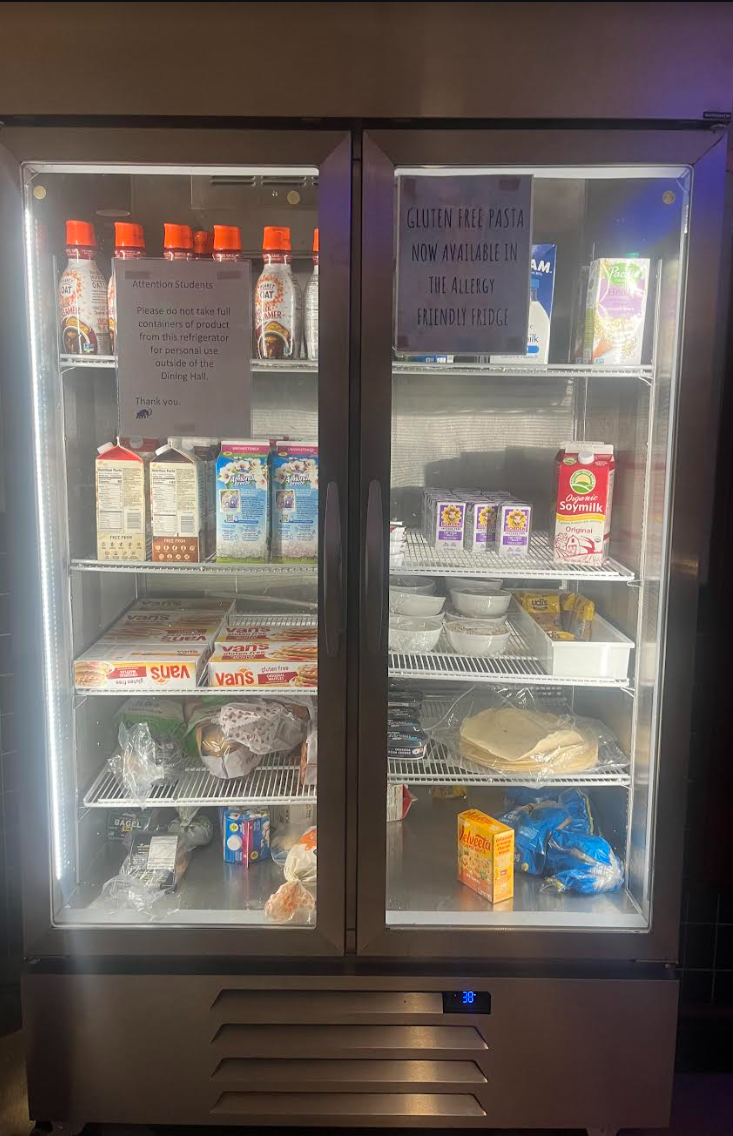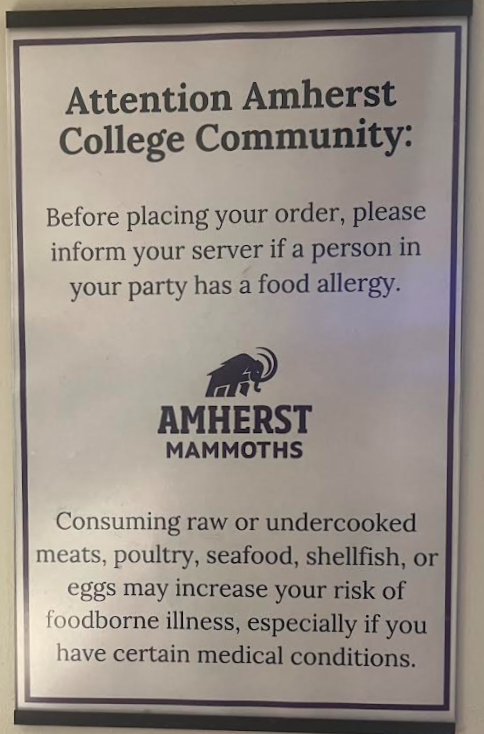Celiac-Safe: Gluten-Free Dining Challenges at Val
Eating at Amherst with celiac disease has proven to be challenging for many students. Managing Features Editor June Dorsch ’27 investigates patterns of cross-contamination and mislabelling that increase the risk of eating at Val with gluten-free dietary restrictions.

Last semester, Maria Clara Kloppenburg ’27 was struggling. She felt sick all the time. Her skin was breaking out into rashes.
“My hair even [started falling] out,” she said.
She did not know why.
By October, Kloppenburg was diagnosed with celiac disease. According to the Celiac Disease Foundation, it is “a serious autoimmune disease that occurs in genetically predisposed people where the ingestion of gluten leads to damage in the small intestine.”
“Symptoms can include gastrointestinal issues, iron deficiency, fatigue, headaches, hives/rashes, and weight loss,” Menu Coordinator and Nutritionist Megan Scutti wrote in an email to The Student.
Kloppenburg could no longer eat food containing any amount of gluten. That includes any product made with wheat, rye, or barley, or prepared in equipment that bears traces of gluten. For example, unless it was thoroughly cleaned, gluten-free cookies cooked in an oven that had previously baked cookies containing gluten would not be safe for people with celiac disease to eat.
But Kloppenburg soon found, like other students at Amherst with celiac disease, that it was a struggle to find food that adhered to her strict dietary restrictions on campus.
With limited options, eating gluten-free at Val can feel repetitive. Cross-contamination is rampant in Valentine Dining Hall. Students have spent hours discussing methods for making Val celiac-safe with Amherst administrators and dining staff. However, students still consistently get sick from Val’s gluten-free options. Through a lack of food diversity, widespread cross-contamination, and mislabelling, Val is making life difficult for students with celiac disease.
Food Diversity
Eating with dietary restrictions at a dining hall does mean that a lot of food options are inaccessible to people with celiac disease. Still, many options remain gluten-free.
“Driven by the needs of our community, especially students, currently a large portion of our daily offerings do fit a gluten-free (GF) or celiac diet such as the lighter side, salad bar, and deli section, plus a total of 120 gluten-free main entrees during lunch and dinner. These options can also easily be paired with offerings from our allergen-friendly fridge,” Scutti wrote.
In addition, Val staff perform menu audits at the beginning of every semester to expand allergen-friendly options.
“[We] look for areas where meals may be trickier for students with various food allergies. After establishing these harder-to-navigate days for those students, we work with our kitchen, dining, and purchasing team to find ways to further improve,” Scutti wrote. “Since the fall we have implemented 14 new recipes that are gluten-free versions of our main entrees that are gluten-heavy.”
Students with celiac disease noted that they have seen improvements in making more meals gluten-free, but still feel that food diversity is a real issue at Val.
“Sometimes when there [aren’t] meals that are gluten-free and they don’t necessarily have [another] option, we’ll have the gluten-free pasta. But sometimes that will be a couple of nights in a row,” Courtney Hall ’27 said. “And so, I’ve had to navigate, like, ‘What can I do with pasta? What can I add to it to make it interesting?’ … That’s definitely hard sometimes.”
Sophie Reed ’27 also eats the gluten-free pasta when there is not a gluten-free hot meal available. For her, it can be frustrating not just because of the repetitiveness, but also because the process of getting her meal takes much longer than it takes for others to get theirs.
“To get my food, it takes like [so long],” Reed said. “My friends are already sitting down at the table by the time I get my [pasta] and microwave it and bring it over. Or when they don’t actually have gluten-free pasta in the fridge, grabbing it [from staff] … I’m [having to make] more of an effort to [just] get my stuff.”
Cross-Contamination
Due to the widespread cross-contamination of gluten-free food at Val, people with celiac disease cannot actually eat many of the options that Scutti listed as being celiac-safe.
Some of these instances of cross-contamination are difficult to reduce, particularly in self-serve areas.
“Pasta sauce is a big one because students would take the pasta sauce and spread it on their [gluten-containing] pasta [where the ladle would touch the pasta]. Not good,” Reed said. “And then also … the salad bar. There’s bulgur … which is literal wheat, just in the middle of the salad bar … When people take it, it can fall into the other compartments.”
A particularly high-risk meal for students with celiac disease is burrito day, since there are so many different tongs that might touch the flour tortillas.
Val staff have made some adjustments to make food selection more accommodating for people with celiac disease, like placing some pasta sauce in the allergen-friendly fridge. But these incidents of cross-contamination are still common, and make students with celiac disease more wary to use certain food stations.
“It has definitely been a little upsetting, but at the same time … I’m gonna have to let that one go,” Hall said.
“A large portion of Valentine Hall is self-serve, which we understand poses a higher risk for cross-contact with allergens,” Director of Dining Services Bill Connor and Scutti wrote in a joint statement to The Student. “We highly encourage students who may be concerned about cross-contact to speak with a staff member in that area and ask to be provided product from a new pan to decrease this risk.”

One of the biggest areas where cross-contamination occurs is the fryer. Sometimes fryers that are used for food that contain gluten are also used for gluten-free food.
“The one meal that I didn’t get sick [from] but probably should have was the wings because I didn’t know that wings [were] fried [in a fryer with gluten] because they don’t really have a good indicator,” Hall said. “So … I ate the wings. I think someone else I know maybe ate them and they got sick, but I didn’t.”
Scutti said, “This semester we have implemented a disclaimer for all items fried in our common fryer: ‘Fried in a common fryer. May contain all top 9 allergens.’”
Cross-contamination may be on the decline, but students still report getting sick from these incidents.
Students emphasize that cross-contact does not need to be this common. Reed thought bulgur should simply be separated from other products in the salad bar. Kloppenburg suggested that people with celiacs could have a separate area to make high-risk meals that have lots of self-serving components. There are concrete steps to mitigate some of these incidents of cross-contamination.
Mislabelling
Certain foods are labeled gluten-free on online menus and on physical labels but are not in fact celiac-safe. Hall and Reed both described oat products, like oatmeal and rolled oats, as a clear example of this.
“Oats technically are gluten-free naturally,” Hall explained. “They can get cross-contaminated though if they’re grown next to a field of wheat or if it’s packaged in the same facility.”
But Valentine Dining Hall purchases oats that are not certified.
“So any dining hall item that says it’s gluten-free with oats in it? It’s truly not safe,” Reed said.
“I understand [buying certified gluten-free oats] is more expensive, because gluten-free items are more pricey,” Hall said. “[But] I think buying certified gluten-free oats seems to be a really easy solution which they haven’t done.”
People with other gluten allergies and restrictions may be able to still eat these products. But people with celiacs cannot. So even though the breakfast rolled oats are labeled as gluten-free (the ingredient list mentions the oats are not certified gluten-free), if a student with celiac disease ate them, they could get sick.
“It’s a little misleading,” Reed said.
The most shocking discovery from this investigation was a mislabelling incident in Fall 2023. Late night is typically a safe meal for students with celiac disease since there is always a gluten-free option. This time the meal was chicken sandwiches. The gluten-free chicken sandwich was also the vegan alternative.
“A lot of vegan meats have gluten in them. And so just from intuition, I knew that and [felt that] this just doesn’t look right. So I [googled] the ingredients of [the meat substitute] and saw one of the main ingredients was wheat,” Reed said.
“So I went up to the counter and told them. I was like, ‘I think that this thing that you’ve labeled as gluten-free is gluten-containing. And they were like, ‘No, no it’s not.’ And so then they’re like, ‘Let’s go check though.’ And so they call down. And then the head chef came up and was like, ‘You caught our mistake. Oh my gosh, I’m so sorry.’”
After that, the Val workers immediately rectified the error and started making sandwiches that were actually gluten-free.
But Reed estimates she caught their mislabelling at roughly 10 p.m., 30 minutes into late night. Other students with celiac disease or other gluten allergies may have eaten the sandwich.
“It’s quite problematic,” Reed said. “Especially because I didn’t see a notice about it [like] ‘If you ate this between now and then you could have had contact.’ Nothing was said.”
Connor and Scutti said in a joint statement to The Student: “Here in dining, students’ safety is our number one concern and priority. All allergen incidents are followed up by our leadership team to learn more on what corrective measures need to be taken for any allergen or safety incident reported to us. The incident mentioned was handled with extreme seriousness by our staff and addressed immediately with the student who brought the concern forward.”
All of these incidents reveal a dining hall that does not properly label its food. Not all food labeled gluten-free is celiac-safe. And though the late night incident was a one-time error, it demonstrates that the dining hall is not being careful enough to ensure food designated allergen-free is consistently allergen-free.
College Responses
Students emphasized that administrators and staff have been willing to work with them to improve food safety in Val. All students interviewed worked with Scutti on navigating Val.
“[Scutti] has been really great,” Hall said. “I’ll definitely either meet with her or email her updates and … I’ll get an email from her if something change[s]. They’ve added stuff on the menu for us.”
However, they do point out that it has required a lot of time and effort to get the college to make proactive changes.
“I think that there [wasn’t] enough understanding of what celiac is,” Reed said. “Like it’s not just like I’m choosing not to eat gluten … it’s an autoimmune disease and it is a disability that is covered by the [Americans with Disabilities Act], and people weren’t realizing that.”
But this semester, Reed has spent hours meeting with staff about celiac disease and dining options, and she has seen changes.
“The overwhelming support I’ve gotten from them now is amazing,” Reed said.
While there seems to be a shift in attitudes from the administration and changes are being made to start to make dining better for students with celiac disease, there is much more that needs to be done. This investigation has revealed institutional disregard around cross-contamination and allergen-tag labeling. Amherst has simply not provided students with dietary restrictions with adequate dietary options or accommodations. It must do so immediately to ensure all students can be safe at Val.





Comments ()